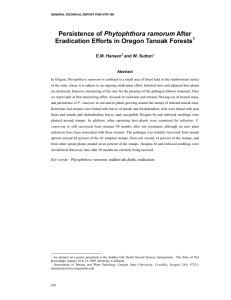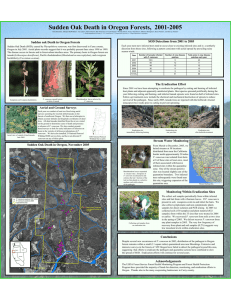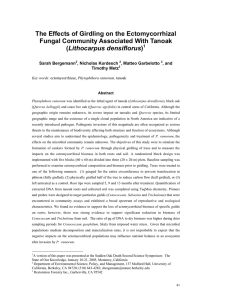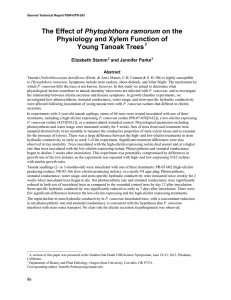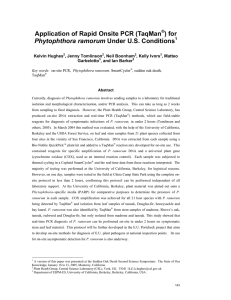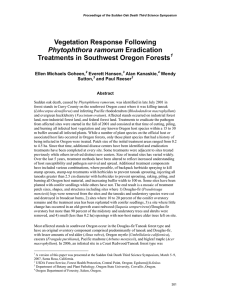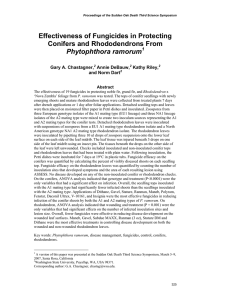Applications of Fungicides to Protect Four Phytophthora ramorum
advertisement
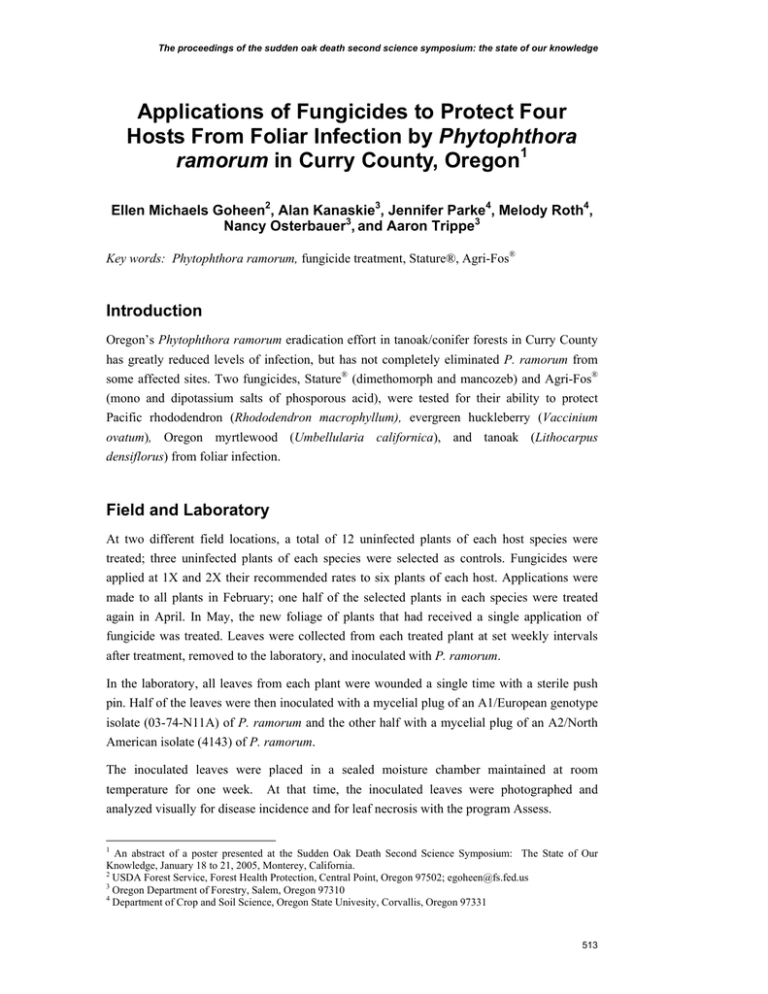
The proceedings of the sudden oak death second science symposium: the state of our knowledge Applications of Fungicides to Protect Four Hosts From Foliar Infection by Phytophthora ramorum in Curry County, Oregon1 Ellen Michaels Goheen2, Alan Kanaskie3, Jennifer Parke4, Melody Roth4, Nancy Osterbauer3, and Aaron Trippe3 Key words: Phytophthora ramorum, fungicide treatment, Stature®, Agri-Fos® Introduction Oregon’s Phytophthora ramorum eradication effort in tanoak/conifer forests in Curry County has greatly reduced levels of infection, but has not completely eliminated P. ramorum from some affected sites. Two fungicides, Stature® (dimethomorph and mancozeb) and Agri-Fos® (mono and dipotassium salts of phosporous acid), were tested for their ability to protect Pacific rhododendron (Rhododendron macrophyllum), evergreen huckleberry (Vaccinium ovatum), Oregon myrtlewood (Umbellularia californica), and tanoak (Lithocarpus densiflorus) from foliar infection. Field and Laboratory At two different field locations, a total of 12 uninfected plants of each host species were treated; three uninfected plants of each species were selected as controls. Fungicides were applied at 1X and 2X their recommended rates to six plants of each host. Applications were made to all plants in February; one half of the selected plants in each species were treated again in April. In May, the new foliage of plants that had received a single application of fungicide was treated. Leaves were collected from each treated plant at set weekly intervals after treatment, removed to the laboratory, and inoculated with P. ramorum. In the laboratory, all leaves from each plant were wounded a single time with a sterile push pin. Half of the leaves were then inoculated with a mycelial plug of an A1/European genotype isolate (03-74-N11A) of P. ramorum and the other half with a mycelial plug of an A2/North American isolate (4143) of P. ramorum. The inoculated leaves were placed in a sealed moisture chamber maintained at room temperature for one week. At that time, the inoculated leaves were photographed and analyzed visually for disease incidence and for leaf necrosis with the program Assess. 1 An abstract of a poster presented at the Sudden Oak Death Second Science Symposium: The State of Our Knowledge, January 18 to 21, 2005, Monterey, California. 2 USDA Forest Service, Forest Health Protection, Central Point, Oregon 97502; egoheen@fs.fed.us 3 Oregon Department of Forestry, Salem, Oregon 97310 4 Department of Crop and Soil Science, Oregon State Univesity, Corvallis, Oregon 97331 513 GENERAL TECHNICAL REPORT PSW-GTR-196 Reisolation of P. ramorum on standard PARP media or DNA extraction and PCR analysis was performed for all samples. Results Overall, treatment effects using foliar application of Stature® and Agri-Fos® to Pacific rhododendron, evergreen huckleberry, Oregon myrtlewood, and tanoak as applied in this field study were limited. We were consistently able to reisolate P. ramorum from symptomatic and asymptomatic leaf tissues regardless of fungicide treatment. We observed significantly reduced lesion area for both A1 and A2 isolates with application of Stature® to newly-emerged tanoak leaves at one week after fungicide application. We observed significantly reduced lesion area for mature evergreen huckleberry leaves treated with AgriFos® and inoculated with the A2 isolate of P. ramorum. Regardless of treatment, inoculation with the A1 isolate of P. ramorum consistently produced significantly larger lesions than the A2 isolate on Pacific rhododendron, evergreen huckleberry, and Oregon myrtlewood, but not on tanoak leaves. Leaf necrosis was significantly greater on newly emerged Pacific rhododendron leaves than on mature leaves inoculated with either the A1 or the A2 isolates of P. ramorum. Lesion size was greater on new evergreen huckleberry leaves than mature leaves when inoculated with A2. On tanoak and the other hosts (although not quite so obvious), as the new foliage matured it seemed to become less susceptible to infection. Acknowledgements Funding for this project was provided by the USDA Forest Service Pesticide Impact Assessment Program (FS-PIAP). Special thanks are extended to South Coast Lumber Company for providing field sites and other assistance. 514
